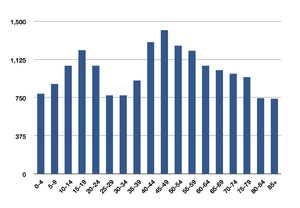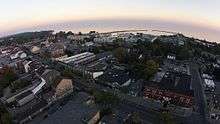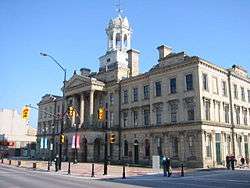Cobourg
| Cobourg | |
|---|---|
| Town (lower-tier) | |
| Town of Cobourg | |
|
Victoria Hall by Kivas Tully | |
| Nickname(s): Ontario's Feel Good Town | |
| Motto: Our Strength Is In Our Unanimity | |
 Cobourg Location of Cobourg in southern Ontario | |
| Coordinates: 43°58′N 78°10′W / 43.967°N 78.167°WCoordinates: 43°58′N 78°10′W / 43.967°N 78.167°W | |
| Country |
|
| Province |
|
| County | Northumberland |
| Settled | 1798 |
| Incorporated | 1837 (town)[1] |
| Government | |
| • Mayor | Gil Brocanier |
| • Council | Cobourg Town Council |
| • MP | Kim Rudd (Northumberland—Quinte West, LPC) |
| • MPP | Lou Rinaldi (Northumberland—Quinte West, LIB) |
| Area[2] | |
| • Land | 22.37 km2 (8.64 sq mi) |
| Population (2011)[2] | |
| • Total | 18,519 |
| • Density | 827.8/km2 (2,144/sq mi) |
| Time zone | EST (UTC−5) |
| • Summer (DST) | EDT (UTC−4) |
| Postal Code FSA | K9A |
| Area code(s) | 905, 289 |
| Website |
www |
Cobourg is a town in the Canadian province of Ontario, located in Southern Ontario 95 kilometres (59 mi) east of Toronto and 62 kilometres (39 mi) east of Oshawa. It is the largest town in and seat of Northumberland County. Its nearest neighbour is Port Hope, 7 km (4 mi) to the west. It is located along Highway 401 (exits 472 and 474) and the former Highway 2 (now Northumberland County Road 2). To the south, Cobourg borders Lake Ontario. To the north, east and west, it is surrounded by Hamilton Township.
History
The settlements that make up today's Cobourg were founded by United Empire Loyalists in 1798. Some of the founding fathers and early settlers were Eluid Nickerson, Joseph Ash, Zacheus Burnham and Asa Burnham. The Town was originally a group of smaller villages such as Amherst and Hardscrabble, which were later named Hamilton. In 1808 it became the district town for the Newcastle District. It was renamed Cobourg in 1818, in recognition of the marriage of Princess Charlotte Augusta of Wales to Prince Leopold of Saxe-Coburg-Saalfeld (later Saxe-Coburg and Gotha, who would later become King of Belgium).
By the 1830s Cobourg had become a regional centre, much due to its fine harbour on Lake Ontario. In 1835 the Upper Canada Academy was established in Cobourg by Egerton Ryerson and the Wesleyan Conference of Bishops. On July 1, 1837, Cobourg was officially incorporated as a town. In 1841 the Upper Canada Academy's name was changed to Victoria College. In 1842 Victoria College was granted powers to confer degrees. Victoria College remained in Cobourg until 1892, when it was moved to Toronto and federated with the University of Toronto. In 1842, John Strachan founded the Diocesan Theological Institute in Cobourg, an Anglican seminary that became integrated into the University of Trinity College in Toronto in 1852.
Standing at the heart of the downtown is Victoria Hall, a building that now serves as the town hall, as well as home of the Art Gallery of Northumberland, the Cobourg Concert Hall, and an Old Bailey-style courtroom that is now used as the Council chamber. Victoria Hall was designed by architect Kivas Tully. The landmark is known for its impressive stone work. Charles Thomas Thomas (1820-1867), an English-born master stonecarver and building contractor, executed the fine stone carvings, including the bearded faced keystone over the main entrance into the building.[3] Victoria Hall was officially opened in 1860 by the Prince of Wales, later to become Edward VII of the United Kingdom, King Edward VII. At that time, Cobourg was a significant town in the Province of Canada, and some townspeople felt that Cobourg would be a suitable capital for the newly united provinces; this privilege went to Ottawa, Ontario, however.
In the late 19th century and early 20th century, wealthy Americans built enormous summer homes there, a few of which still stand today. One notable home, on King Street East, became the Brookside School - now a youth detention centre. A major ferry service connected Cobourg and Rochester, New York from 1907 to 1952, transporting passengers and cargo across Lake Ontario, allowing Americans to reach the town more readily. The Cobourg and Peterborough Railway ran northward over Rice Lake to Peterborough, but the lines collapsed into Rice Lake in the late 1800s. After World War II and the advent of improved transportation technology, this economic link decreased in importance.
On December 20, 1951, Cobourg experienced media attention as a Curtiss C-46 Commando crash landed in local farmer Charles Wilson's field.[4][5]
Cobourg was the site of No. 26 Ordnance Depot, later Canadian Forces Station Cobourg, from 1953 to 1971.
Throughout the late 1980s and early 1990s, the town invested heavily in purchasing property along the waterfront and beautifying the area. A boardwalk was developed to connect the harbour and large sandy beach while further pathways were created to encompass Victoria Park and the historic downtown. Because of this renewal and revitalization, many community activities now revolve in and around these spaces.
Transportation
Highway 401 and Northumberland County Road 2 (formerly Highway 2) pass through town. County Road 45 (formerly Highway 45) begins in Cobourg and heads north-east to Norwood.
The Canadian Pacific and Canadian National main railway lines (Toronto – Ottawa/Montreal) traverse the town. Via Rail offers passenger service to Cobourg railway station with multiple daily departures on the Toronto – Ottawa/Montreal route.
Cobourg Transit is a fully accessible community transit system that provides daily bus service to the town. The community transit system ends its runs by 7pm, which can hamper travel for those without other means of transportation. It formerly ran until 9:30pm however the hours were reduced.
The Ontario Waterfront Trail passes through Cobourg and cyclists can be found moving through daily during the warmer months.
Demographics
| Historical populations | ||
|---|---|---|
| Year | Pop. | ±% |
| 1841 | 3,347 | — |
| 1871 | 4,442 | +32.7% |
| 1881 | 4,957 | +11.6% |
| 1891 | 4,829 | −2.6% |
| 1901 | 4,239 | −12.2% |
| 1911 | 5,074 | +19.7% |
| 1921 | 5,327 | +5.0% |
| 1931 | 5,834 | +9.5% |
| 1941 | 5,907 | +1.3% |
| 1951 | 7,470 | +26.5% |
| 1961 | 10,646 | +42.5% |
| 1971 | 11,282 | +6.0% |
| 1981 | 11,385 | +0.9% |
| 1991 | 15,079 | +32.4% |
| 1996 | 16,185 | +7.3% |
| 2001 | 17,172 | +6.1% |
| 2006 | 18,210 | +6.0% |
| 2011 | 18,519 | +1.7% |
| Canada census – Cobourg community profile | |||
|---|---|---|---|
| 2011 | 2006 | 2001 | |
| Population: | 18,519 (1.7% from 2006) | 18,210 (6.0% from 2001) | 17,172 (6.1% from 1996) |
| Land area: | 22.37 km2 (8.64 sq mi) | 22.37 km2 (8.64 sq mi) | 22.37 km2 (8.64 sq mi) |
| Population density: | 827.8/km2 (2,144/sq mi) | 814.0/km2 (2,108/sq mi) | 767.6/km2 (1,988/sq mi) |
| Median age: | 46.1 (M: 44.0, F: 48.0) | 41.9 (M: 40.1, F: 43.6) | |
| Total private dwellings: | 8541 | 7571 | 7142 |
| Median household income: | $53,573 | $47,046 | |
| References: 2011[2] 2006[6] 2001[7] | |||

Age Profile
- Age 0-14: 18.1%
- Age 15-24: 11.9%
- Age 25-44: 24.7%
- Age 45-64: 24.2%
- Age 65-74: 10.8%
- Age 75+: 10.3%
Religious Make Up
- 56.1% Protestant
- 23.9% Catholic
- 2.2% other Christian
- 0.7% other religions
- 17.1% non-professing
Racial Profile
- 91.4% White
- 4.4% Aboriginal
- 3.8% Korean
- 0.7% Black
Attractions
Cobourg retains its small-town atmosphere, in part due to the downtown and surrounding residential area's status as a Heritage Conservation District. The downtown is a well-preserved example of a traditional small-town main street. Victoria Hall, the town hall completed in 1860, is a National Historic Site of Canada.[8][9] The oldest building in the town is now open as the Sifton Cook Heritage Centre and operated by the Cobourg Museum Foundation.

Cobourg has a multitude of beautiful, well-maintained parks. The Cobourg Waterfront Festival, held in Victoria Park and the nearby beach and harbour, is an annual arts and crafts event occurring on Canada Day. It began in 1987 as a part of the town's sesquicentennial celebrations, and was conceived by the Art Gallery of Northumberland's former Director/Curator Peter Tulumello and former Concert Hall Manager Mark Finnan. Cobourg's oldest annual event the Cobourg Highland Games was started in 1963 in Donegan Park by Dave Carr to celebrate the Scottish culture in this area. In 2013 for its 50th Anniversary it will be moved to Victoria Park and will be held on the 3rd Saturday in June.
In addition to two high schools (Cobourg Collegiate Institute (CCI) and St. Mary's Secondary School (SMSS) ), Cobourg is home to a satellite campus of Fleming College. Food processing is the largest industry in Cobourg, and it is home to operations of companies like SABIC Innovative Plastics and Weetabix. There are also elementary schools in Cobourg such as C.R. Gummow Public School, Terry Fox Public School, Merwin Greer Public School, St. Michaels Catholic School, St. Josephs Catholic School, Burnham Public School, Notre Dam Catholic School, Dale Road Public School, and Grant Sine which recently closed down.
Cobourg's beach, Victoria Park Beach, is very popular among residents and tourists of Cobourg. Host to volleyball tournaments, events, beach days, family picnics and more. The beach is equipped with a splash park, playground set, park area for eating, local restaurants and a pier. There are lifeguards on duty some days and it is safe to swim and play in. Close to the downtown, tourists can shop in local shops and eat out at many of Cobourg's fine dining restaurants.
Media
- Northumberland Today, owned by Osprey Media, is a daily newspaper with content contributed from the Cobourg Star and Port Hope Guide.
Radio
Five radio stations are licensed to Cobourg, providing music, news and local programming to Northumberland County and surrounding areas.
- FM 89.7 - CFWN, not-for-profit community-based, volunteer driven, programming focused on the community
- FM 90.7 - CHJJ, Christian music
- FM 93.3 - CKSG, adult contemporary
- FM 103.1 - CFMZ, classical
- FM 107.9 - CHUC, classic hits
TV
Cobourg uses cable 10 to broadcast local events and weather. Apart from that, Cobourg has no local terrestrial television stations; the closest is CHEX-TV in Peterborough, Ontario.
Notable residents
- John Douglas Armour, Puisne judge of the Supreme Court of Canada
- Charles Arkoll Boulton, militia leader in the Red River Rebellion
- Alan Bradley, author
- Jeremiah Brown, Canadian Men's Eight Rowing Team, won silver at the 2012 London Olympic Games
- Mandy Bujold, Canadian Boxer
- James Cockburn, lawyer and Father of Confederation
- Marie Dressler, silent film actress, Academy Award winner best actress 1931
- Francis P. Duffy, Canadian-born Military Chaplain of the Fighting 69th New York Regiment during WWI
- Sir Sandford Fleming who helped create and define the idea of time zones
- Rev. John Weir Foote, politician, chaplain, and Victoria Cross recipient
- Ed Greenwood, author of the Forgotten Realms setting for Dungeons & Dragons
- Henry Bowyer Lane, English born Toronto architect
- Ebenezer Perry, Cobourg's police commissioner
- William Renwick Riddell, judge and historian
- Dave "Goldie Rogers" Sherwin, professional wrestler
- Orlando B. Willcox, United States Army general and Medal of Honor winner lived here from 1905-1907 until his death [10]
- Justin Williams, NHL hockey player, 3-time Stanley Cup champion, winner of 2014 Conn Smythe Trophy
Schools
References
- ↑ 1878 Illustrated Historical Atlas of Durham and Northumberland Counties of Ontario. Toronto: H. Belden & Co. 1878. cited in "Historical Facts, 1878: Cobourg". Archived from the original on 3 September 2013. Retrieved 8 October 2007.
- 1 2 3 "Cobourg Census Profile". 2011 Census of Population. Government of Canada. Retrieved 15 March 2012.
- ↑ Leonard, Jim (December 1989). "Charles Thomas: A Stonemason's Legacy Restored". SSAC Bulletin. Ottawa: Journal of the Society for the Study of Architecture in Canada (SSAC). 14 (3).
- ↑ 1 Archived September 27, 2007, at the Wayback Machine.
- ↑ 2 Archived September 27, 2007, at the Wayback Machine.
- ↑ "2006 Community Profiles". Canada 2006 Census. Statistics Canada. March 30, 2011. Retrieved 2012-03-15.
- ↑ "2001 Community Profiles". Canada 2001 Census. Statistics Canada. February 17, 2012. Retrieved 2012-03-15.
- ↑ Victoria Hall / Cobourg Town Hall. Canadian Register of Historic Places. Retrieved 14 July 2014.
- ↑ "Victoria Hall - Cobourg's Town Hall". Cobourg History. Cobourg Internet. Archived from the original on 24 August 2013. Retrieved 28 July 2011.
- ↑ "Orlando Bolivar Willcox". Find A Grave. Retrieved 14 July 2014.
External links
| Wikimedia Commons has media related to Cobourg, Ontario. |
 Cobourg travel guide from Wikivoyage
Cobourg travel guide from Wikivoyage- Official website
 "Cobourg". Encyclopædia Britannica. 6 (11th ed.). 1911. p. 613.
"Cobourg". Encyclopædia Britannica. 6 (11th ed.). 1911. p. 613.- CobourgHistory.ca
- Cobourg subreddit
- Northumberland Today
- Northumberland Tourism
 |
Hamilton Township |  | ||
| Hamilton Township | |
Hamilton Township | ||
| ||||
| | ||||
| Lake Ontario |
